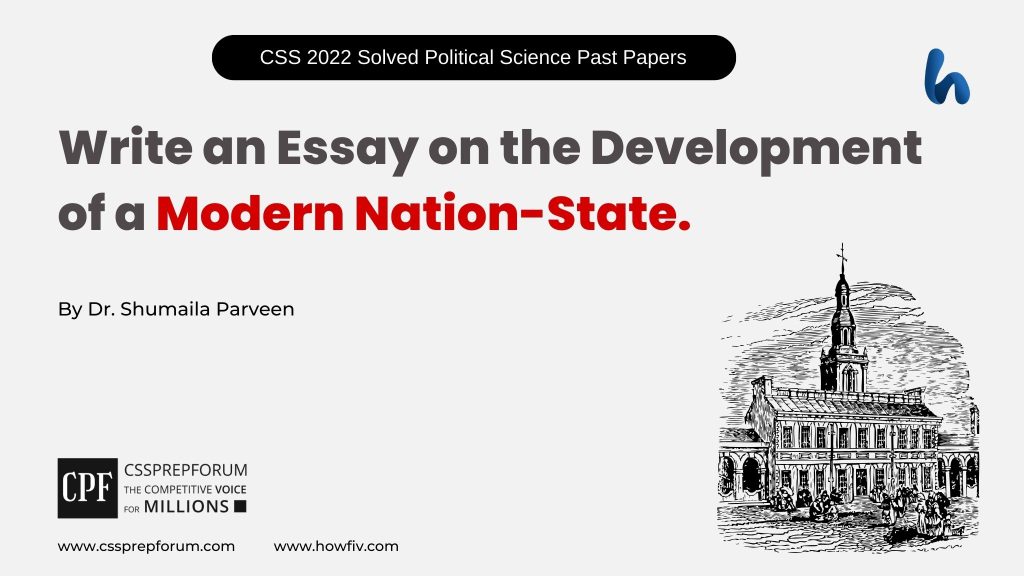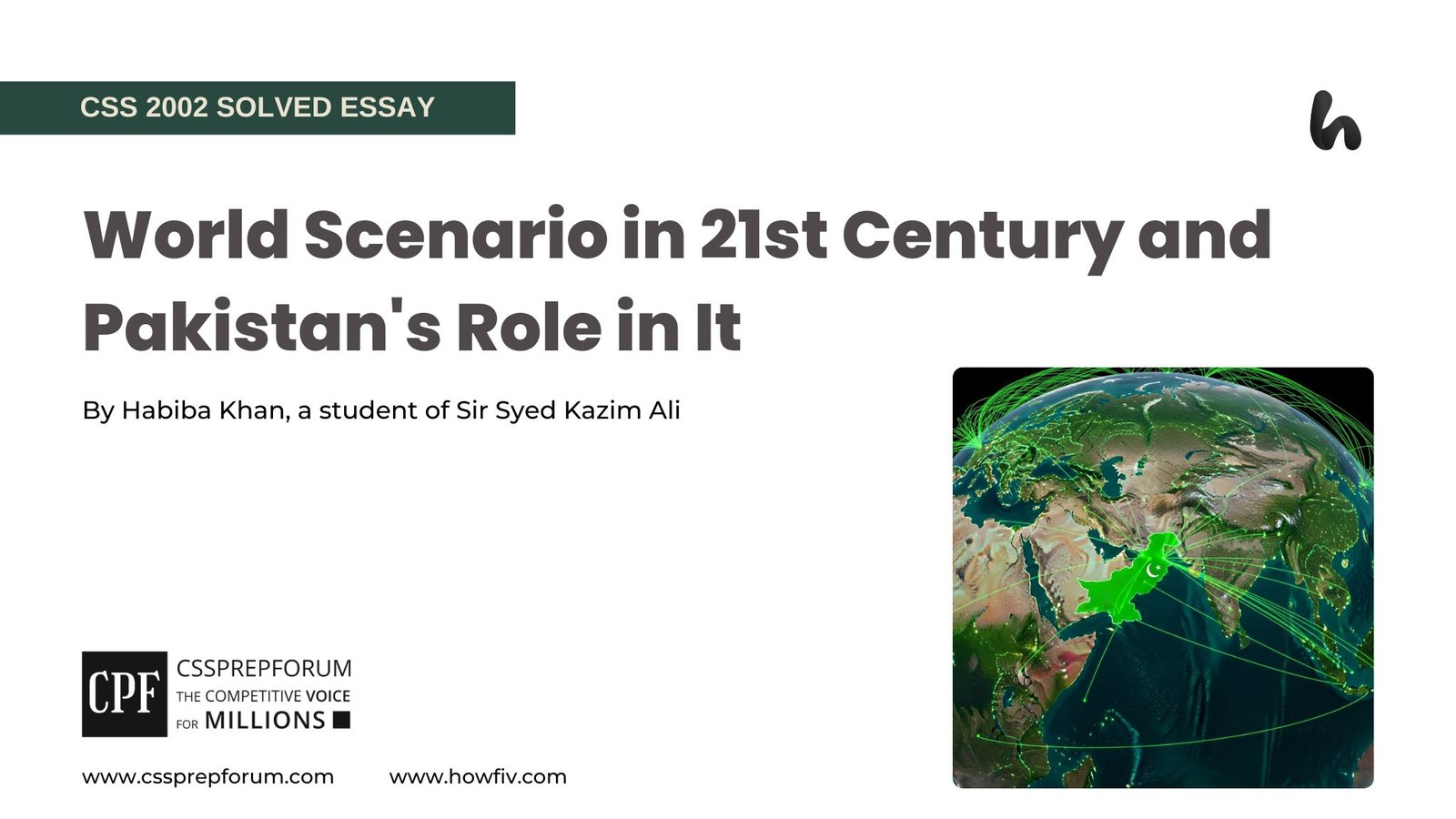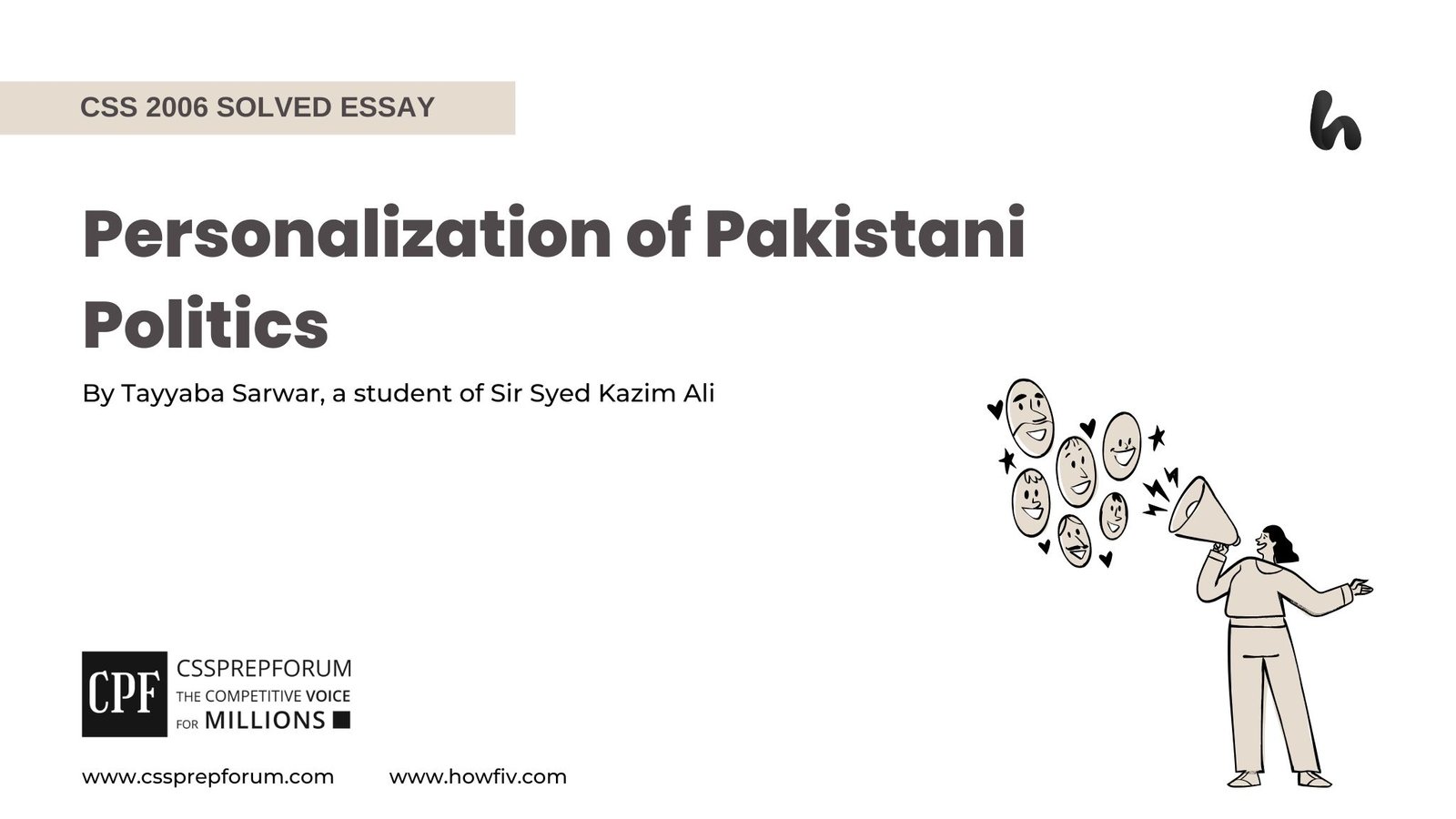CSS Solved Political Science 2022 Past Paper | The Development of a Modern Nation-State
The following question is attempted by Miss Dr. Shumaila Parveen, the top scorer in CSS Political Science papers. Moreover, the answer is written on the same pattern, taught by Sir to his students, scoring the highest marks in compulsory subjects for years. This solved past paper question is uploaded to help aspirants understand how to crack a topic or question, how to write relevantly, what coherence is, and how to include and connect ideas, opinions, and suggestions to score the maximum.

Question breakdown
The question demands a thorough investigation of the evolution of a modern nation-state. The answer is divided into many parts to provide a comprehensive understanding of the topic: start with an introduction, evaluate the pre-nation-state conditions, impetuses towards modern nation-state formation, and the distinctiveness of modern nation-states. Then, wrap up the answer by providing a conclusion.
Outline
1-Introduction
The Treaty of Westphalia was signed to curtail kings’ arbitrary powers and unauthentic taxation systems, policies, and dominance and reduce the disintegration of religious affiliations, especially in Central Europe. An international accord allowed different European nations to formulate numerous sovereign states within a defined territory and devise a democratic form of government.
2-Deciphering the terminology “Modern nation-state”
3-Evolution of Modern Nation State
- ✓Pre-conditions of nations
- Monarchies and Empires
- Religions in coordination with politics
- ✓Towards modern nation-state – the Treaty of Westphalia
- The concept of a single-nation
- Autonomy of states
- Geographical integrity
- International accords and balance of power
4-Configuration of modern nation-states – contingent on the Treaty of Westphalia
5-Primary impetus for the modern nation-state
- ✓Militarism
- ✓Centralism
- ✓Capitalism
6-Distinctiveness of modern nation-state
- ✓ Self-rule
- ✓Defined population
- ✓Territorial authority
- ✓Written constitution
- ✓Foreign policies and International treaties
7-Conclusion

Answer to the question
1-Introduction
Humans, being social animals, have jointly settled in a society to interdependently accomplish their requirements and hassles. Nonetheless, society has evolved over the millenniums, and men have tolerated the burdens of monarchies, royal regimes, social contracts, and submissive practices before the leadership to achieve the current form of the modern nation-state. In pursuit of a democratic and self-ruled government, the real struggle started in Europe in the early 1600s. The Treaty of Westphalia was signed to curtail the arbitrary powers of kings and their unauthentic taxation systems, policies, and dominance and reduce the disintegration of religious affiliations, especially in Central Europe. It was an international law that allowed different European nations to formulate numerous sovereign states within a defined territory and devise a democratic form of government. Furthermore, the ingredients of centralism, capitalism, and militarism gave flavour to the movements to form a modern nation-state. Thus, a self-determined democratic state has evolved with a defined territory, an exact population, a constitutional document, and an astute foreign policy. The present model of the modern nation-states and governments is the practical manifestation of the Treaty of Westphalia.
2-Deciphering the terminology “Modern Nation-state”
A nation-state is one in which every citizen and leader, including the head of state, shares a common identity, such as having the same language, religion, culture, and mercantile system, sharing a defined area, and possessing common interests. A modern nation-state means a legitimate state, in addition to possessing all the characteristics of the nation-state, governs a dynamic industrial economy, induces the democratic principles of fundamental rights and social activism, holds central authority, and persuades legal forces to maintain law and order in a specific geographical territory.
3-Evolution of the concept of modern nation-state
The formation of the modern nation-state is a thorny tale of human struggles, endurance, and suffering, especially of common men. Thence, a terse apprehension of the pre-modern nation-state condition of the international polities provides a better understanding of the formation of the modern nation-state.
- ✓Pre-conditions of Nations
The destructive Thirty Years’ War in Central Europe between 1618 and 1648, mainly between Catholics and Protestants, the two religious’ cliques, triggered the momentum towards the modern nation-state’s formation. Furthermore, the widespread rebellions among religious groups, no satisfaction with the commands of the monarch, and bloody war among the Holy Roman, Spanish, Sweden, and Dutch Empires, under the pretext of helping their dynastic allies, assimilated colossal unrest in Europe, eventually, demanded a peace agreement that came in the form of the Treaty of Westphalia. Moreover, the disintegration of the Ottoman Empire, Austria-Hungry Monarchy, Mughal Empire, and Britain’s realms on religious, language, and cultural grounds further strengthened the nation-state’s formation. Similarly, the fall of the Soviet Union was another step toward the evolution of the Modern nation-state.
- ✓Towards modern nation-state – the Treaty of Westphalia
The dawn of the 17th century witnessed substantial political chaos in Europe. The events, such as the breakdown of the general faith in the Church of England and the formation of multiple religious identities, Catholics and Protestants, had stirred the authority of the monarchies and kingdoms in Europe. In addition, the self-assertive roles of the kings gained prime authority, and a war started on religious bases and turned into political tussles. Upon failure of the self-assertive hegemony of Kings- a treaty was signed known as the Treaty of Westphalia. This treaty was a series of peace accords among the numerous European nations signed between May and October 1648 in the Westphalian cities of Osnabruck, known as the Treaty of Osnabruck and Münster, called the Treaty of Munster, resultantly; it ended the pubic objections on the authorities and the thirty years’ war in Central Europe. It recognized the independence of the Netherlands, granted Sweden control over the Baltic region and gave Alsace and Lorraine to France. The Peace of Westphalia was an international law granting exclusive sovereignty to states over their territories. The following are the primary features of the Treaty of Westphalia.
- ✓The concept of a single-nation
First, the Treaty of Westphalia was also considered to initiate a single nation-state. Over the many years of religious and political tussles, Europe was divided into many states, mainly the formation of states on the foundation of race, language, religion, and culture. Hence, in a modern nation-state scheme, every state has one or few religious identities, a particular language or a set of a few languages, and homogenous cultural affinity, automatically giving rise to a state that protects people’s fundamental rights and satisfies their needs and legitimate demands. Moreover, in a modern nation-state, instead of a rightful ruler, a democratic, elected person would act as the head of government and govern a nation for a specific period.

- ✓Autonomy of states
Another important postulate of the Treaty of Westphalia was the concept of Sovereignty. It means every king or polity would be sovereign in its definite territory, having separate religions or maintaining a state secularism. The autonomy model further asserted that every king, from now on, would be self-assertive in its territory, and no external power would have the right to compel the internal rule of the king. The self-determined, constitutionally independent modern nation-states have derived this principle’s legitimacy. In addition, the contemporary notion of sovereignty or autonomy has been made clear by the UN Article 01, the South Asian Association for the Regional Corporation’s Article X, and the Shangai Cooperation Organization’s Article ix, which clearly state that all nation-states are independent in their internal as well as external affairs, and no state is binding to any international treaty, agreement, or accord, and no higher authority could coerce a state to sign any international concurrence.
- ✓Geographical integrity
Next, the Peace of Westphalia mindfully implemented the territorial division to stop European political and religious chaos. Even after the treaty, the concepts of sovereign states and loose monarchs existed at that time. These states and kingdoms had limited authority in their particular geographical areas and by no means had any authority over the other state’s affairs, whether internal or external. On the same line, the existence of a modern state system has been formulated. The period of three centuries has sharpened these rules, and, eventually, every nation has been given the right to a piece of land, like the formation of modern nation-states through the Red Cliff Commission, the formation of Pakistan and India, the Treaty of Louisiana, and the Treaty of Severus, the division of Ottoman Empire among the Middle East, Turkey, and Europe.
- ✓International accords and the Balance of Power
Lastly, the creation of the Peace of Westphalia was the beginning of an international accord, which stated that no state would interfere in other states’ political affairs. In addition, the agreement shatters the centuries-old religious hegemony in Europe, where the administration was religiously governed by the pope and temporally governed by the rightful monarch, and the state’s politics was separated from religion. Thus, optimistic morality at the international level has been generated, and the creation of international laws has safeguarded the sovereignty of each state. On this basis of the exact genesis, international accords have been fabricated. For instance, the International Court of Justice (ICJ) provides justice to suppressed nations, and the United Nations Laws of Seas (UNCLOS) has defined territorial sea boundaries and maritime trade routes.
4-The main factors behind the formation of a modern nation-state
Under the pretext of the Treaty of Westphalia and later, the incidents of World War I provided necessary justification for the modern nation-state. Initially, the religious wars followed by capitalism, militarism, and centralism made the evolution of the nation-state inevitable. The unprecedented incidents of the global wars and the Middle East political crisis became the primary impetus to the modern nation-states’ assembly. According to Anthony Giddens, a nation-state is a “Modern container of Power.” To elaborate, a nation-state can mobilize its economy, administrative functions, militaristic resources, technological assets, and human power, and the highest authority in a modern state is enjoyed by the government through constitutional provision. In addition, the modern manifestations of old laws are the crucial social processes, forms of government, constitutional principles, civil society, human rights, and trade policies.
5-Primary impetus for the modern nation-state
- ✓Militarism
The most famous factor in forming a modern state nation was militarization. According to Max Weber, the exclusive policy of a state is a legitimate utility of coercing within a defined geographical area. A state is a political society where the administration exercises its monopoly to maintain control and stability, using power, penalty, detention, and violence over a determined territory. Similarly, the evolution of the modern nation-state started with physical violence, either the formation of the US, China, or European nations, securing further authority within a defined geographical area to shelter the legitimacy of a nation-state.
- ✓Centralism
Moreover, another stimulus towards the establishment of a modern nation-state is centralism. Centralism is when an organization or specific leadership accumulates political power, planning, and decision-making authority to attract like-minded people, generating resources to legitimize a particular cause. David Held describes centralism as “The ability to wage war and extract resources, men power, military might, or territorial dominancy,” given the evolution of the modern nation-state, the period before World War I, the rise of central monarchs, political ambience before and after the Second World War, the Arab War, and the Balfour Declaration, every chronicle targeted the centralism as an impetus towards the formation of a modern nation-state.
- ✓Capitalism
Finally, capitalism gave the state a higher social control and coordination influence. With the start of the Industrial Revolution, the introduction of communication network, and later, the economic schemes of a free market, the concept of private property, and surplus generation provided more and more impetus to the disorientation of unity of people, dividing them into different classes and cliques on religious and economic bases. The case study of American capitalism, in contrast to Soviet socialism and globalization versus nationalism, pushed for the evolution of a modern state. Similar to the treaty of Westphalia that curtails the unnecessary authority of the monarch in the modern nation-state, instead of the head of government, levying taxes, formulizing monetary policies, and introducing an economic system are the functions of a state’s government.
6-Distinctiveness of modern nation-state
Discussing the distinctiveness of the modern state, it possesses many exclusive characteristics. For instance, present-day nation-states have unparalleled authority over a particular territory, encompass a defined population, and contain a written constitution. Each modern nation-state adopts certain rules, regulations, and foreign policies while interacting and coordinating with other states. Current policies also pursue certain international agreements; nonetheless, modern nation-states are not binding to any international accords. To conclude, owing to the principles of the Treaty of Westphalia, a base for a modern nation-state was established. As a result, modern nation-states have been formed where religion has subjective rule and procures no stance in most states’ politics.
7-Conclusion
To conclude, it is stated that the contemporary form of a modern nation-state is an evolved concept of polity. To ponder over the disturbance in global politics that started in the 17th century in Central Europe, the tug of war between two Christian sects, Catholics and Protestants, started, which soon converted into political tussles. The status of the king was regarded as a synonym for corruption, illegal policies, and exploitation of the masses and their resources. In addition, the disintegration among religious affiliations further worsened the scenario. In the entire cry, a political law or charter in the form of the Peace of Westphalia was introduced in the belligerent kingdoms. Eventually, the treaty gave space to each nation and allotted certain rights, territories, and policies to effectively manage inter-state and intrastate affairs. The sovereignty of each state was safeguarded, and the role of religion was reduced to a subjective level. Besides, in formulating the present form of a modern nation-state, capitalism, militarism, and centralism also provided their due share. Thus, the most fragmented yet highly tolerant form of modern nation-states develop. However, their sovereignty is limited to a determined territory, and over the defined number of people, which contains specific culture and language, inter-state relations, international peace, economic accords, and tolerance to numerous religions, it is much better now.

CSS Solved Past Papers’ Essays
Looking for the last ten years of CSS and PMS Solved Essays and want to know how Sir Kazim’s students write and score the highest marks in the essays’ papers? Then, click on the CSS Solved Essays to start reading them.
CSS Solved Essays

CSS Solved General Science & Ability Past Papers
Want to read the last ten years’ General Science & Ability Solved Past Papers to learn how to attempt them and to score high? Let’s click on the link below to read them all freely. All past papers have been solved by Miss Iqra Ali & Dr Nishat Baloch, Pakistan’s top CSS GSA coach having the highest score of their students.
General Science & Ability Solved Past Papers
CSS Solved Pakistan Affairs Past Papers
Want to read CSS Pakistan Affairs Solved Past Papers and learn how to attempt them to score high? Let’s click on the link below to read them all freely. All past papers’ questions have been attempted by Sir Kazim’s students, who scored the highest in the subject.
CSS Solved Pakistan Affairs
CSS Solved International Relations’ Past Papers
Have you opted for International Relations in the CSS examination and want to score above 150? Then, click on the CSS Solved International Relations’ Past Papers by Miss Abeera Fatima, the top IR scorer and the best IR coach in Pakistan.
CSS Solved International Relations Past Papers












